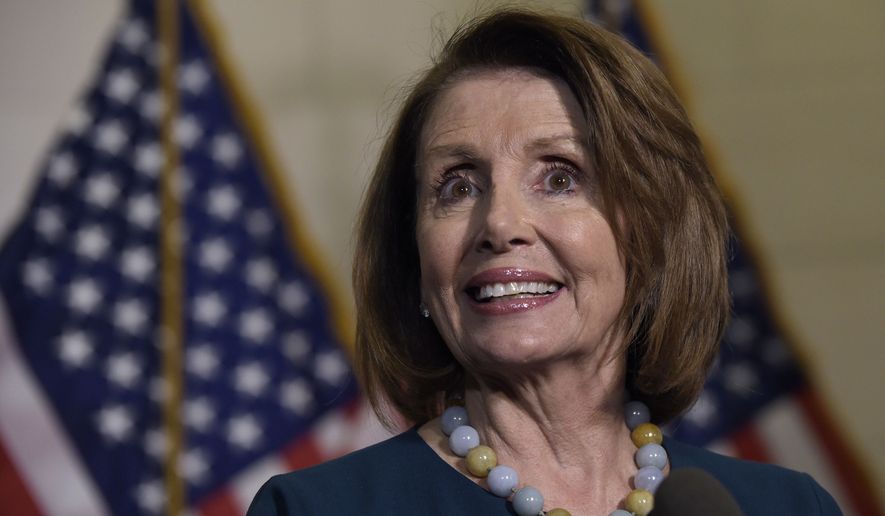
House Minority Leader Nancy Pelosi of Calif., speaks to reporters following the House Democratic Caucus elections on Capitol Hill in Washington, Wednesday, Nov. 30, 2016, for House leadership positions. Rep. Tim Ryan, D-Ohio, challenged Pelosi, but lost, 134-63. (AP Photo/Susan )
By Seth McLaughlin – The Washington Times
House Democrats renewed Rep. Nancy Pelosi’s lease on power Wednesday, voting to keep her as party leader and insisting she bears no blame for her party’s staggering electoral losses over the past six years.
She faced her toughest challenge yet in her 14 years at the helm, ceding more than 60 votes to Rep. Tim Ryan, a 43-year-old Ohio Democrat who said the party had lost touch with middle America and needed a shake-up to begin connecting — and winning — again.
Mrs. Pelosi’s backers agreed that the party must do more to reconnect with voters in the “flyover” states but said Democrats’ problems are the fault of others. They said the 76-year-old has the political mettle and fundraising prowess to be what one lawmaker called their “comeback leader.”
“This is a time, I think, that we need someone who is battle-tested. And there is no stronger battle-tested person than Nancy Pelosi,” said Rep. Elijah E. Cummings of Maryland.
Mrs. Pelosi won on a 134-63 vote, held behind closed doors.
Democrats also kept the rest of their top leadership, electing Rep. Steny H. Hoyer, 77, of Maryland to the No. 2 job of whip, and Rep. James E. Clyburn, 76, of South Carolina to the No. 3 post of assistant leader.
That lineup hasn’t changed in a decade, as the party won a majority in the 2006 elections then watched it slip away in 2010 and failed to take it back in the three elections since, despite twice winning the presidential popular vote.
Emerging after her victory, Mrs. Pelosi told reporters that she had “a special spring in my step today” and said she could craft a winning message that reaches all parts of the country.
“We know how to win elections,” she said. “We’ve done it in the past. We will do it again.”
Her supporters blamed their party’s electoral misfortunes on factors such as gerrymandering of congressional districts, the WikiLeaks emails and Hillary Clinton’s message on the campaign trail.
“When Hillary Clinton came to my hometown of Toledo, Ohio, and stood at the busiest Amtrak terminal in Ohio, she did not speak about her infrastructure bill,” said Rep. Marcy Kaptur. “She talked about Warren Buffet. … Most people in my district don’t even know who he is.”
Ms. Kaptur said, “I was dumbfounded.”
Mr. Ryan did manage to force some changes. Mrs. Pelosi signaled that she would try to give more junior members a bigger say in decisions.
But his supporters questioned how Mrs. Pelosi could help the party become more competitive with blue-collar voters in the Rust Belt and Midwest that helped power Donald Trump to victory over Mrs. Clinton and helped give Republicans key wins that kept their majorities in the House and Senate.
“I don’t know how someone gets elected in the Midwest when they say, ‘Elect me; I am going to make Nancy Pelosi the speaker of the House,’” said Rep. Stephen F. Lynch of Massachusetts. “I don’t know how we win with that message.”
The Republican National Committee, meanwhile, said Democrats are tone-deaf.
“This year, voters went to the polls and made a bold statement for change in Washington, but House Democrats just doubled down on the status quo,” the RNC said in a statement. “The American people have been trying to send the Democrat Party a message by selecting historic numbers of Republicans for office at nearly every level of government but Nancy Pelosi’s re-election shows Democrats aren’t listening.”
Mrs. Pelosi has become one of the more polarizing figures in Washington since taking over in 2003 as leader of the House Democratic Caucus.
She became the first female speaker of the House in 2007 and watched over the party as its majority grew to 256 seats in 2009. But House Democrats have since suffered through a series of electoral stumbles and generated rumblings about Mrs. Pelosi’s leadership.
In 2010, Rep. Heath Shuler of North Carolina ran against Mrs. Pelosi and garnered 43 votes.
When the next Congress convenes in January, Republicans are poised to have at least 240 seats and Democrats will hold 194 seats. Control of one Louisiana seat will be decided in a Dec. 10 runoff.
Channeling the anxiety over the electoral setbacks, Mr. Ryan came closer than anyone else to stripping Mrs. Pelosi of her leadership title. He said after the vote that he was disappointed but proud of his showing and the impact the effort had on the party.
“You know, we made a few enemies, we cracked a few eggs along the way, but you know, [you] can’t make an omelet without breaking a few eggs,” he told reporters.
Mrs. Pelosi, in announcing her bid to keep her position, said she had the support of two-thirds of her Democratic colleagues — and she ended up with almost exactly that tally.
As the vote neared, Mrs. Pelosi rolled out a series of changes to caucus rules aimed at giving junior lawmakers more say. But more experienced members, particularly those in the Congressional Black Caucus, said the proposed changes were unfair because they punished seniority.
⦁ David Sherfinski contributed to this report.
___
http://www.washingtontimes.com/news/2016/nov/30/nancy-pelosi-re-elected-leader-house-democrats/
